|
Guilin
Guilin, situated in the northeast corner of the Guangxi Zhuang Autonomous Region, it is hailed by many as the most beautiful place in China and is one of the must-see destinations for most foreign tourists. According to a popular Chinese saying, “Guilin’s scenery bests all others in the world.” Its shapely-rising limestone towers and crystal-clear waters are often portrayed in Chinese artworks.
Guilin named after the fragrance of osmanthus, built in Qin Dynasty over 2,000 years ago, prospering in Tang and Song, flourishing in Ming and Qing.
Located in the subtropical zone, Guilin boasts a pleasant climate for sight-seeing throughout the four seasons. It is inhabited by 12 nationalities with a total population of 1,260,000.
Today’s Guilin ranks the second respectively on the list of China’s ten best scenic spots and that of China’ top forty tourist spots. With her new appearance today, she is ready at any moment to bid you welcome.
Recommended Guilin Tour:
Recommended China Tours Including Guilin:


|
Tourist Highlights
|
| |
Li River Cruise
The Li River cruise from Guilin to Yangshuo is the centerpiece of any trip to northeastern Guangxi Province. Guilin scenery is acclaimed as the "Best Under Heaven" and the most beautiful scenes are found along the Li-River. Gorgeous Karst peaks give you surprises at each bend of the limpid river under the blue sky. Water buffalo patrol the fields, peasants reap rice paddies, school kids and fisherman float by on bamboo rafts. With its breathtaking scenery and taste of a life far removed from the concrete metropolis, the scenery along the Li River become one of China's top tourist destinations.
The trip starts from the dock south of Liberation Bridge in Guilin downtown area. Otherwise some agencies will transport tourist to by a one-hour bus ride to catch the cruise. The river trip is over eighty kilometers (52 miles) long and is estimated to take seven to eight hours. The eye-feasting landscape and country scenery will never disappoint you.
|
 |
|
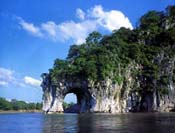 |
Elephant Trunk Hill
Situated majestically at the southeast of Guilin city and west bank of Li River, Elephant Trunk Hill is regarded as the symbol of Guilin landscape. Originally named "Li Hill", "Yi Hill" and "Chenshui Hill", the hill has a history of 3.6 hundred million years. It looks like an elephant drinking water at the confluence of the Taohua River and the Lijiang River.
With an elevation of 200m, the hill towers 55m above the water, measuring 108m in length and 100m in width. A round open space between the elephant trunk and its body is called Water-Moon Cave. At a clear night the moon seems to fall on the bottom of the water and at the same time float on the water surface.
On the walls in and around this cave, over 70 inscriptions from the Tang and Song dynasties were found, praising the beauty of hills and waters nearby.
|
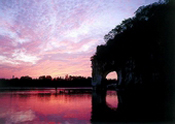 |
|
Reed Flute Cave
A cave is found in the middle of Guangming Mountain in the northwestern suburbs of Guilin. Legend has it that the reed growing by the cave's mouth could be made into flutes, thus the Cave's name "Reed Flute Cave." The Reed Flute Cave is a brilliant cave marked on almost all travel itineraries.
Inside this water-eroded cave is a spectacular world of various stalactites, stone pillars and rock formations created by carbonate deposition. Illuminated by colored lighting, the fantastic spectacle is found in many variations along this 240-meter-long cave. Walking through the serried stone pillars, tourists feast their eyes on changing spots, feeling they are in a paradise where the Gods live.
|
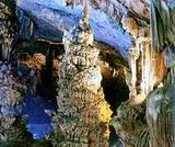 |
|
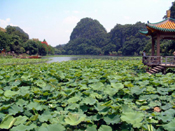 |
Seven Star Park
Seven Star Park is on the eastern side of the Li-River in the Guilin city. This delightful park that has been landscaped to encompass hills and natural waterways is a great favourite with the local people and tourists alike.
The park takes its name from the fact that the four peaks on Putuo Hill and the three peaks on Crescent Hill that form the main part of the park replicate the pattern of the seven stars in the Ursa Major constellation (Great bear or Big Dipper). A further hill, known as Camel Hill is another attraction of the park. This limestone outcrop looks exactly like a camel resting among the trees. The main entrance to the park is over the Flower Bridge [Hua Qiao], an elegant arched structure dating from the Song Dynasty that crosses the confluence of Xiaodongjiang [East River] and Lingjian Stream that passes through the park.
|
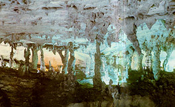 |
|
Fubo Hill
Fubo Hill (Wave Subduing Hill), yet another of Guilin's karst mountains, has one of the most unique and interesting shapes of all the hills around here and contains many interesting sights. The mountain itself resembles a wave reaching up to the sky and descending down into the river.
The sights on the hill include a temple to the Wave Subduing General (Fubo Jiangjun), after whom the hill is named. Elsewhere on the hill, Returned Pearl Cave and Thousand Buddhas Cave are also great places to see some Tang and Song Buddhist statues. Lastly, the Wave Listening Pavilion, on the southeast cliff of Fuboshan, is a great place to view the surrounding area. Built in 1964, while not ancient, the Pavilion is a great place to relax and take in the natural beauty of the Guilin area.
|
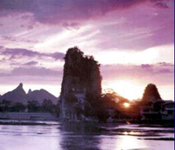 |
|
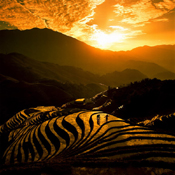 |
Longsheng Terrace
In the south-east of Long Sheng County in Guangxi Province and within the land of Ping Xiang, there is a group of large-scaled rice terraces built into the hillside. Some of the terraces look like great chains, other look like ribbons. They wind from the foot to the top of the hill. The smaller ones are like snails and the bigger ones like towers. There are layers on layers of terraces, high and low. The outline is very smooth. Its scale is enormous. It is called "The champion of the terrace world". It is the Dragon's Backbone Rice Terraces. By the way, Long Sheng is also the gathering land for the minorities, such as Yao, Dong, Zhuang and Miao. The stockaded villages' backs face the hills and their fronts face the river.
The Dragon's Backbone Rice Terraces is 27 kilometers from Long Sheng County, and it is 80 kilometers from Guilin city. The total area of this scenic spot is 66 square kilometers. The altitudes of the terraces vary between 300 meters & 1100 meters with sloping grades between 26 degrees and 35 degrees. The steepest slope is 50 degrees. Although there are terraces everywhere in the mountain areas of South China, it is extremely rare to see a terrace as big as the dragon ridge terrace.
|
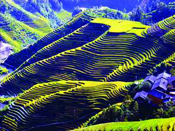 |
| |
Recommended Guilin Tour:
Recommended China Tours Including Guilin:


|
|
| Other City |
|
|
 |
| Private China Tours |
|
|
 |
|

